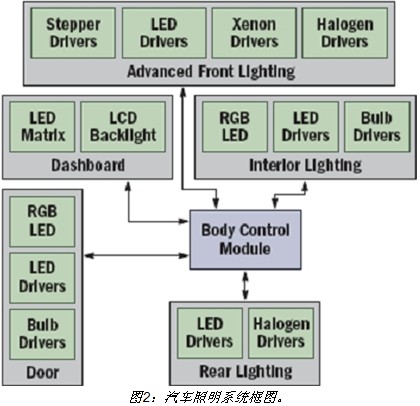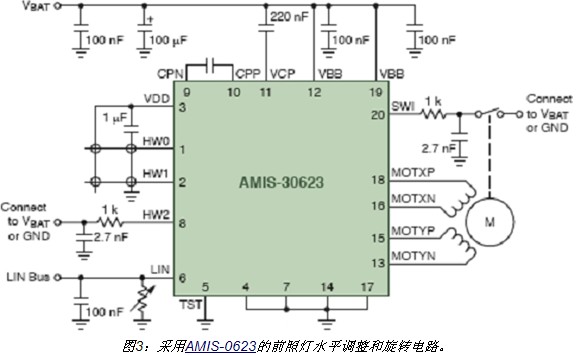In today's mid- to high-end cars, modern lighting concepts are becoming more and more vivid. Whether it's exterior lighting or interior lighting, it's stylish and personal. The mood setting mode is used in different parts of the car to control the color and brightness of the "personal space", such as the driver's foot space or the backlight of the console. This type of automotive lighting uses a new type of light source to meet the requirements of environmental protection and energy saving while enriching the consumer experience.
To achieve advanced automotive lighting applications, it must be supported by the corresponding semiconductor technology. As a leading supplier of automotive lighting solutions, ON Semiconductor has been providing a variety of general-purpose and dedicated energy-efficient device solutions for automotive lighting applications, in line with automotive applications. Strict requirements to meet the rapidly growing market demand.
Modern car lighting system
In recent years, light-emitting diodes (LEDs) have been widely used in automotive lighting applications. LED-based lighting systems offer longer life, lower power consumption, and greater design flexibility than incandescent lamps. These features make it ideal for automotive interior lighting applications. In addition, as technology continues to advance, white LEDs with lower cost and higher light output per watt have emerged, making LEDs more suitable for a variety of lighting applications inside automobiles.
LEDs are used in a wide range of applications in automobiles, such as in the interior of a car roof or in the lower interior of a car door, focusing light on specific areas inside and outside the car. The LED can also be integrated into the door handle, keyhole, pedal, cup holder, or as a turn flash on the mirror. The shape of the illuminating indicator can be very simple or very beautiful, to meet the precise lighting, to provide convenience and beauty, as shown in Figure 1.

ON Semiconductor's advanced automotive lighting solutions
ON Semiconductor has been providing standard and custom devices for automotive lighting applications, including general lamp driver solutions, as well as stepper drives, LED drivers and high-intensity discharge lamps (HIDs such as xenon lamps). In the HID driver-specific integrated circuit (ASIC) market, ON Semiconductor's headlamp level adjustment and rotary stepper drivers have been widely adopted in the industry. In the automotive LED lighting market, ON Semiconductor offers a broad portfolio of products for both interior and exterior applications. In the block diagram of the automotive lighting system shown in Figure 2, ON Semiconductor has a variety of corresponding products. The following are some of the main solutions.

Headlamp stepper motor driver
Most of today's cars are equipped with high-beam (HB) and low-beam (LB) halogen lamps, which are the main functions of the headlamps. High-beam halogen lamps typically consume 55 W and have a light output of approximately 1,000 lumens. HID technology has been around for more than a decade, with a power consumption of about 35 W and a light output of about 3,500 lumens, which has certain application advantages. Over time, HID lamps have integrated the high beam function into a dual xenon lamp solution. However, due to the high brightness and glare of HID affecting the line of sight of the vehicle, some countries require automatic adjustment of the height of the low beam.
Another important aspect of automotive headlamps is the beam rotation of the Advanced Headlamp System (AFS) to optimize the visibility curve, while the Adaptive Beam (ADB) function adjusts the beam according to real-time conditions. Stepper motors are the preferred controller for AFS and ADB.
ON Semiconductor's AMIS-30623 single-chip bipolar stepper motor driver is suitable for horizontal adjustment and rotation control of headlamps. The device features an integrated position controller and local interconnect network (LIN) interface for a dedicated mechatronic solution design for remote connection to a LIN host, as shown in Figure 3. It uses configurable parameters such as current, speed, acceleration and deceleration to receive position commands via the bus and drive the motor coil to the desired position. The AMIS-30623 can also detect motor stalls.
The device embeds a dedicated finite state machine and a custom LIN command set for advanced headlamp systems. It also integrates sensorless step loss detection to improve reliability, reduce component count and board space, and reduce Product Cost.

2. LED headlamp system power ballast and dual LED driver
At present, most cars still use the halogen headlamp scheme to provide high beam and low beam, but the future trend is to use xenon and LED lights. In particular, LED lamp applications that can significantly reduce the power consumption of headlamps will rise rapidly. 30% of cars will be equipped with a variety of LED headlamp functions within 5 years. LED lighting offers a more sleek choice for "instant" illumination and allows for brightness control from 0% to 100% power.
